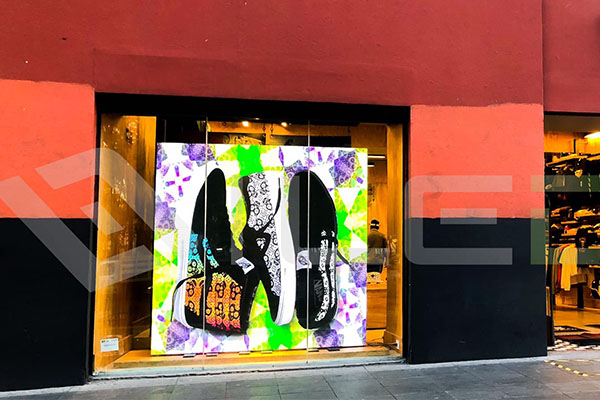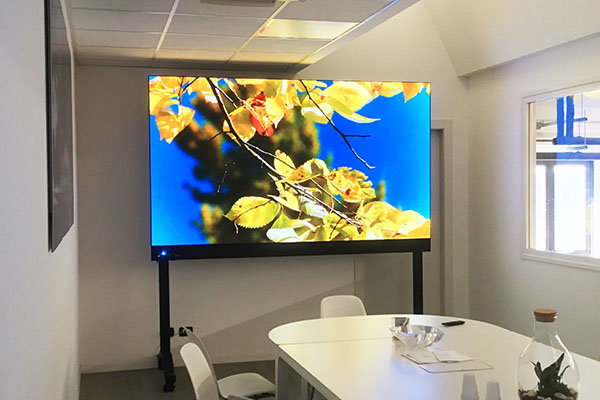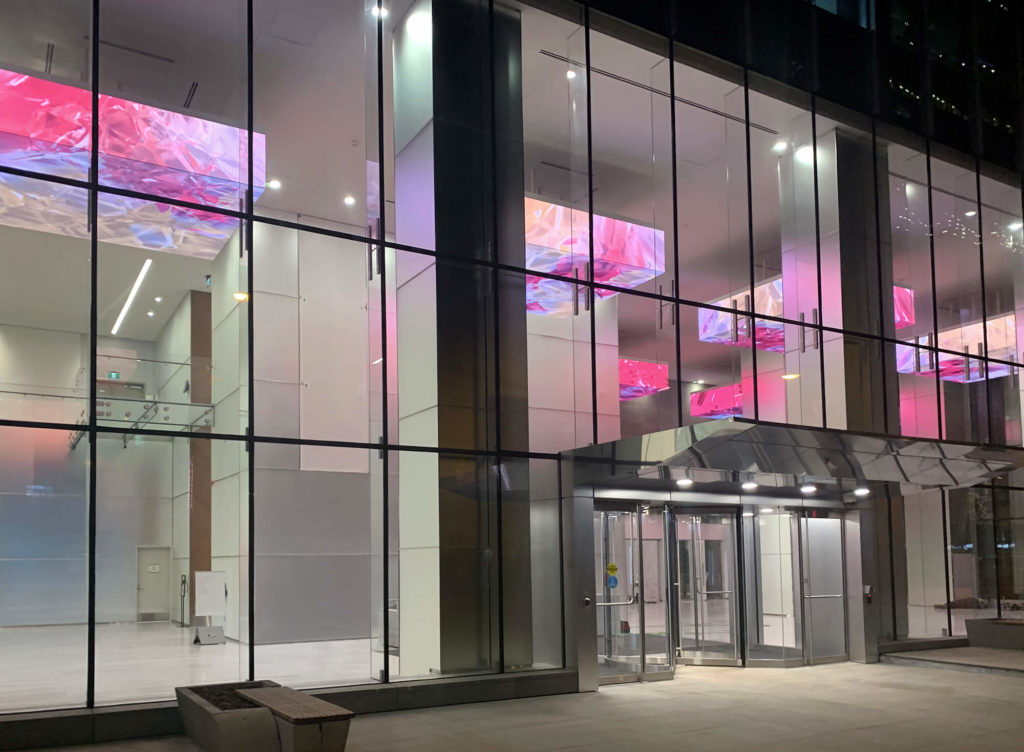Advantages and disadvantages of a LED screen
Is the result always better if I use a LED screen ?
The visual communication market is increasingly going in the direction of the LED technology, which is the most flexible solution for creating modern screens with a high visual impact in size and brightness.
But this is not always the optimal solution for customer needs. In some cases, a video wall solution or even a single LCD monitor is even better. There are so many technical characteristics and commercial requests that it is advisable to thoroughly investigate all aspects of the project and highlight the positive and negative aspects of each technology before making our choice.
Our expert and specialized consultant will explain all the technical aspects and construction details, so that the choice is optimized and profitable.
Screen Size and Resolution
The first enemy of the LED wall is the resolution in small sizes. When the detail required for our images is a 4K, the size of the LED wall will have to reach high levels, 220″ or 270″ (to talk about products sold at reasonable prices) with consequent problems of installation, dimensions and, above all, cost. While an excellent 4K solution is obtained with a single LCD monitor with dimensions up to 100″ and with a cost that can be enormously lower, even a tenth, compared to the LED wall solution.
If the size, on the other hand, is not a problem but, in fact, a large image surface is needed to give visibility to more people, LED wall allows you to obtain a 4K resolution, for any screen size requested by choosing one of the many pixel pitch options available. In this way we reduce the complexity of the control system and scaler by working with a standard 4K. In contrast, a video wall solution would require additional effort in content creation and control system, due to a much higher screen resolution than 4K.
Design, shape and aspect ratio
LCD monitors, and therefore video walls made with them, have the big advantage of the aesthetic design. They are well finished, refined and “mature products”, designed to be touched and seen up close and therefore with an attention to detail that, today, LED walls do not have. The use of a single LCD monitor obviously limits the final shape to a rectangle in a vertical or horizontal position, although in different sizes, and with a typical aspect ratio of 16:9 and, in some recent products, can be stretched to 32:9 or similar. The combination of many LCD monitors in a video wall system gives space to the imagination of designers who can combine multiple monitors both in the typical matrix configuration but also in more artistic, inclined and asymmetrical configurations, suitably managed by an ad-hoc control system.
This flexibility of construction and artistic fantasy reaches its top after the introduction of the LED wall. The mechanical structure of the LED wall panel allows to create large screens both with a standard 16:9 aspect ratio and with any other aspect ratio as well, horizontally or vertically. In addition, the LED wall panel has a typical minimum size of about 25 cm x 25 cm. Starting from this “tile”, designers and architects can imagine unique, creative, original, complex shapes and can give space to any artistic fantasy.
And to improve things, the first LED wall panels with even more innovative shapes begin to appear on the commercial market; triangular, round, flexible …
We have seen that a LED wall screen solution cannot always be considered the most suitable choice, in all situations and for all our customers.
There are several topics to be evaluated and the support of an expert consultant helps us to take into consideration all aspects, even the secondary ones, in order to find the solution that meets commercial needs but at the same time respects specific technical constraints.
The required resolution, size, shape and screen aspect ratio are certainly the main aspects to be discussed and carefully evaluated. But there are other aspects, often considered secondary which can be very important if not even binding in some situations, such as brightness and viewing angle.
Brightness
The brightness of the environment in which the screen will be installed is fundamental for the choice of technology to be adopted.
Stores, malls, train stations and airports are often very bright places where visual communication requires high brightness to be efficient. Even many workplaces such as meeting rooms and conference hall are often well lit and it is not always possible to darken the environment sufficiently in case of need. Finally, in open spaces, such as street advertising panels, or the so-called “semi-outdoor” areas, such as shop windows, the very high brightness of the screen becomes binding and essential.
The “brightness of the front surface” emitted by the LCD monitor and LED wall is measured in candles per square meter or “nit”. Standard indoor professional LCD monitors’ brightness goes from 300 nits to 700 nits, but can reach 1.500 nits for semi-outdoor devices and 3.500 nits for outdoor products.
Where the brightness emitted by the LCD monitors, and therefore by the video walls made with them, is not enough to contrast the ambient light, the LED walls come and help us. A typical indoor LED wall’s brightness goes from 800 nit to 1.200 nit. 3,500 nit is the typical brightness of a LED wall for shop windows or semi-outdoor and for outdoor products a brightness of 10.000 nit is easily achieved.
Such high values in brightness could be excessive at certain hours of the day, if not completely troublesome. Environment light probes are therefore available that can be connected to the LED wall control electronics which allow the screen brightness to be gradually reduced as the ambient brightness decreases in order to maintain an optimal ratio.
Viewing angle
When many people look at a screen, it can happen that some are central to the image while others are more lateral. In these cases the viewing angle becomes important, i.e. the angle beyond which the image is no longer “acceptable” in terms of contrast, colorimetry and brightness.
Obviously this definition is not very scientific and varies among the manufacturers. Basically, based on the product data sheets, all professional LFD monitors have a viewing angle, both horizontal and vertical between 170° and 178°.
For the LED walls, on the other hand, the viewing angle is slightly reduced due to the construction technology since, moving away from a central position, the single monochromatic emitting diodes disturb each other, mainly altering the original colorimetry. Traditional SMD LED walls therefore have a viewing angle ranging from 140° to 160° with the vertical angle slightly lower, often, than the horizontal one.
With the new LED wall COB (Chip on Board) technology now adopted by several manufacturers especially by those who are pushing in the direction of FPP (fine pixel pitch), you will have, in addition to many other advantages, viewing angles of 170 ° both horizontal and vertical.
What other technical, optical and logistical aspects should we consider when a customer asks us the typical question: “Is it better to install a video wall or a LED wall?”.
In addition to resolution, size, shape, projection ratio, brightness and viewing angle, what are the other fundamental features that differentiate a screen made with an LCD monitor rather than with LED panels?
Frame or seamless ?
The last optical aspect to consider is certainly the presence of thin black frames between the monitors of an LCD video wall rather than the complete absence of them (seamless) in a good quality and well installed LED wall. The most recent video walls using the latest generation LCD monitors can reach thicknesses of these frames of 0,5mm although the most common products have frames of about 1,5mm thickness. In this case it will be our customer who will have to evaluate how annoying these black lines are in the final result, especially in function of the video content transmitted, and how much he is willing to spend more to not have them.
Mechanical characteristics
In addition to the electro-optical characteristics which are fundamental and evident in the final result, it is better to always keep in mind also the mechanical characteristics which, in some cases, can be equally important in the final choice. These characteristics must be weighted both during installation and during maintenance.
From a mechanical point of view, thanks to a completely different construction technology, LED panels have practically only advantages compared to traditional LCD monitors and video walls.
Transport and logistics
The first advantage of LED panels is related to transportation. LCD monitors up to the size of 55” have measures compatible with traditional transport and can be handled on standard pallets. With larger dimensions, however, transport becomes “non-standard”, with an increase in costs and risk of damage.
LED panels vary in size depending on the manufacturer, model and field of application, but always compatible with a standard pallet. In addition, the typical construction robustness of the LED panels means that the frequency of failures during transport and handling is very low.
Weight is also important, referring to transport and fixing structure costs. A typical fixed indoor LED panel weighs about 25kg/sqm, while a traditional or video wall LFD monitor ranges from 35kg/sqm and up.
Shocks strength and maintenance
The most important and evident mechanical difference between LED wall and video wall is the robustness to shocks and faults in general. In the event of a frontal impact or on a side edge on the LCD panel, the monitor is often irreparably damaged. This requires replacement of the entire monitor with high inefficiency and the risk to install, in substitution, a different colorimetry monitor.
The LED panel, like all electronic devices, is also subject to failure due to manufacturing defects or accidental impacts. However, the LED panel is much more impact resistant than an LCD monitor, especially the front ones.
In the event of an accidental collision and failure of one or more LEDs (switching off or alteration of the color), it is sufficient to replace a small module (or LED tile) (normally supplied as a spare part, therefore with identical colorimetry) to have the complete operation of the screen in a short time and without disservice. The faulty module will be subsequently repaired in the laboratory and made available for future use without any effect on the original colorimetry. The other possible faults on an LED screen, which may involve the power supply, signal transmission or control part, can also be easily restored “on site” without interruption of service by using the spare parts originally supplied.
Final considerations
Those highlighted, are only the main and most obvious features to consider when asked the frequent question: “is a video wall or a LED wall better ?”.
The customer’s answers will allow us to better understand his needs and to give precedence to the most important aspects for him, which can be related to resolution, dimensions, shape, colorimetry, brightness, mechanical strength, …
Only after having discussed at least these main topics, we can be sure that we have recommended to the customer a product suitable for his present and future needs.








